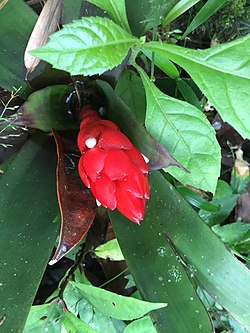Biology:Guzmania desautelsii
From HandWiki
Short description: Species of flowering plant
| Guzmania desautelsii | |
|---|---|

| |
| Scientific classification | |
| Kingdom: | Plantae |
| Clade: | Tracheophytes |
| Clade: | Angiosperms |
| Clade: | Monocots |
| Clade: | Commelinids |
| Order: | Poales |
| Family: | Bromeliaceae |
| Genus: | Guzmania |
| Species: | G. desautelsii
|
| Binomial name | |
| Guzmania desautelsii L.B.Smith & R.W.Read
| |
Guzmania desautelsii is a species of Bromeliads in the genus Guzmania.[1] A plant native to Costa Rica, Nicaragua and Panama,[2][3][4] the species was originally described by Robert William Read and Lyman Bradford Smith in 1983.[5][1]
Description
Guzmania desautelsii flowers at 20–30 cm (7.9–11.8 in) high. The leaves of 30–70 cm (12–28 in) grow in rose-like clusters and are greyish-purple to green.[1] It was first described in 1983 as follows:[1]
PLANT: flowering 2-3 dm high. LEAVES: rosulate, 3-7 dm long, greyish-purple to green beneath, densely punctulate-lepidote throughout becoming less so apically; sheaths distinct, elliptic, ca. 10 cm long; blades ligulate, acute, often acuminate, 3-5 cm wide. SCAPE: erect or ascending, glabrous; scape bracts erect, densely imbricate, the lowest subfoliaceous, the upper subelliptic, acuminate, mostly widely scattered lepidote but densely so apically. INFLORESCENCE: simple, ovoid, ellipsoid or subglobose strobilate, fertile throughout, 7-10 cm long. FLORAL BRACTS: elliptic, to broadly rounded wholly erect and imbricate, thin, chartaceous with membranaceous margins, ca. 4 cm long, exceeding the sepals, orange to scarlet at anthesis, obscurely pale lepidote. FLOWERS: 6-seriate. SEPALS: glabrous, firm, even, coriaceous, obtuse, short-connate, slightly carinate, ca. 20 mm long, wholly covered by the floral bracts. PETALS: white, ca. 28 mm long, barely exserted from bracts, connate for most of their length.
Distribution
Occurrences of Guzmania desautelsii have been documented in Costa Rica and Panama.[1] This range is also confirmed in records on the Global Biodiversity Information Facility[6] and citizen science efforts.[7]
References
- ↑ 1.0 1.1 1.2 1.3 1.4 , Wikidata Q107224589
- ↑ Kew World Checklist of Selected Plant Families
- ↑ Luther, Harry E. (1995). "An Annotated Checklist of the Bromeliaceae of Costa Rica". Selbyana 16 (2): 230–234. ISSN 0361-185X. https://journals.flvc.org/selbyana/article/view/120747.
- ↑ BSI Journal V33(1), Guzmania desautelsii A Name for a Formerly Misplaced Species retrieved 8 September 2011
- ↑ "Guzmania desautelsii | International Plant Names Index". https://www.ipni.org/n/902127-1.
- ↑ "Guzmania desautelsii Read & L.B.Sm." (in en). https://www.gbif.org/species/2699172.
- ↑ "Guzmania desautelsii" (in en). https://www.inaturalist.org/taxa/870129-Guzmania-desautelsii.
Wikidata ☰ Q5623007 entry
 |

